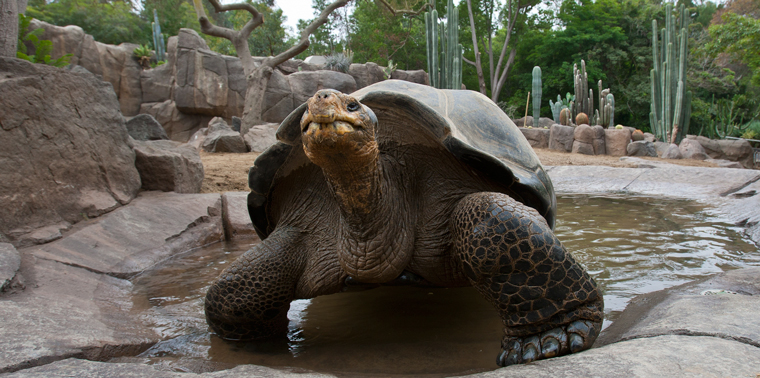May 19, 2014 — From Hollywood stars to Silicon Valley geniuses, California is known for its talent pools. Among the most talented — and perhaps least appreciated — is shuffling, scurrying, diving and thriving in the heart of San Diego at the San Diego Zoo.
The animals and plants that make their homes there — more than 700,000 species in all — know how to do the most astounding things, from freeze solid without harm to turn colors at will. Now, thanks to a zoo initiative known as the Center for Bioinspiration, businesses and others are able to tap those talents as a source of design ideas.
The center, a division of San Diego Zoo Global, uses its massive biodiversity base to connect clients with the spectrum of solutions nature has come up with over billions of years of evolution to design challenges such as combining strength and flexibility, reducing the need for harsh chemicals, or improving aerodynamics. The result benefits both the environment and the business’s bottom line, as nature’s elegant solutions not only boost appreciation for (and so desire to protect) biodiversity, but also typically improve efficiency and reduce waste.
“It’s another way to engage people around the value of nature … not as something to dominate or control, but to be inspired by and create mindfully alongside.” -Gabriel Miller
“The zoo has always been interested in conservation, in connecting people to wildlife and inspiring people to care and take positive action toward having a more sustainable or responsible place in the ecosystem,” says Gabriel Miller, director of research and development for the center. “It’s another way to engage people around the value of nature … not as something to dominate or control, but to be inspired by and create mindfully alongside.”
Ideas for Innovation
The seeds of the center were planted a half-decade ago when the zoo, approaching its centennial, started looking for new niches for its future. CFO Paula Brock was reading Natural Capitalism, a 2008 book on synergies between economic and environmental goals. The book’s discussion of biomimicry — the practice of turning to living things as a source of ideas for human innovation — intrigued Brock. She began thinking about how facilitating that practice might a good fit for the zoo’s conservation mission, both building appreciation and value for the plants and animals the zoo seeks to protect and helping innovators create products that are inherently good for the environment, with high efficiency, low waste and closed loops. She envisioned the zoo as a resource that would introduce businesses to the creatures that could help them solve design challenges — a sort of tour guide through nature’s idea factory.
When the zoo hosted its first bioinspiration conference in November 2009, hundreds of people showed up. “We started to realize there is a real interest, especially in our city with its focus on sustainability, the entrepreneurial spirit, biotech — a lot of interest in plugging into this process,” says Claire Wathen, corporate programs manager for the center. In order to share the concept and concrete aspects of bioinspiration with the world beyond its gates, the zoo decided to launch the Center for Bioinspiration in 2012.
A major part of the center’s work today is helping corporations explore design challenges. “Our role is to provide a fresh environment for them to consider their challenge and a biological lens to look at the areas they’re interested in,” says Wathen. “The zoo [provides] a fresh venue and space where they can consider the questions … a proactive way to bring nature into the conversation.”
Begin With the Basics
The center’s corporate programming begins with the basics. Zoo educators, scientists, horticulturists and keepers participate in workshops before a client visits to explore how their knowledge connects with a given challenge. What does a pinecone know how to do that a personal care products company might find useful? How can a city government benefit from baboons?
“I knew biomimicry was going to be in Sprint’s future one way or the other.” -Darren Beck
Ideas in turn are fed to companies in two ways. One is through a workshop that outlines the principles behind bioinspiration and suggests broad approaches to applying it to business challenges. For those who wish to jump in with both feet, the center provides customized innovation workshops, in which center staff brings zoo plants and animals to the design teams working to solve specific design challenges.
Darren Beck, director of environmental initiatives for the telecommunications company Sprint, learned of the center in 2012. After visiting with Wathen, “I knew biomimicry was going to be in Sprint’s future one way or the other,” he recalls. When Beck ran the idea of a collaboration between the center and the company by folks back at Sprint, the company agreed to add the center staff — and the zoo’s plants and animals — to the team tasked with developing more sustainable packaging for the company’s smartphones.
Eye-Opening Experience
The first step in nature-guided design is figuring out exactly what you’re trying to accomplish. In Sprint’s case, the goal was packaging that was flexible, durable, recyclable, lightweight, aesthetically pleasing and environmentally friendly. Next comes “ideation” — essentially, a process where center staff shows the company plants and animals that are pertinent to the problem at hand.
“This is where the fun begins,” Beck says. “It’s amazing how getting out of the office and getting into the zoo is kind of a creative and eye-opening experience in itself. You have this childlike reaction. We all remember our field trips to the zoo; it was a time in our lives where we were so much more open the possibilities.”
During the daylong ideation process Beck and a contingent from Sprint, guided by Wathen and Miller, looked, listened, poked, prodded and pondered. Sources of inspiration included a tortoise whose shell is both strong and flexible; birds of paradise, with their bright colors; a three-banded armadillo, which can roll into a perfect sphere to protect itself against harm; and a hedgehog with spines able to withstand astounding amounts of force.
Then it was time to flesh out the preliminary ideas. For that, a materials scientist joined the Sprint team on another trip through the zoo. “It’s one thing to know this idea leads to this concept, but how do you execute that?” Beck says. “So the last session we wanted to do something around materials specifically, then also focus on thematic design as well as customer touch and feel — so there is no question this is something that draws from nature’s inspiration.”
Although the packaging solution the team developed has not yet hit the shelves, Beck already has his eye on the next bioinspired design project: exploring what nature can teach Sprint about how to run a communications network efficiently.
Efficient routing in telecommunications networks, it turns out, has a lot in common with finding bits of crumbs on the kitchen floor and taking them back to the ant hole with the least energy expended.
“From a sustainability standpoint it’s about energy — using massive amounts of energy to pump data back and forth across tens of thousands of cellphone towers across the country,” he says. “Around 87 percent of electricity we use as a company is about keeping the network humming. How do you deal with that?”
In the world of nature, you look at ants. Efficient routing in telecommunications networks, it turns out, has a lot in common with finding bits of crumbs on the kitchen floor and taking them back to the ant hole with the least energy expended. “I would at some point down the road like an opportunity to apply bioinspiration to our network,” Beck says. “Could that be something that allows us to engineer the next generation of efficiency?”
Global Impact
All told, more than a dozen clients have tapped into the center’s plant- and animal-assisted design services, including P&G, Nike and NASA. Repeat customers are not unheard of; one client has been back four times. The center is also building collaborations with other zoos and botanical gardens in Israel, Germany, South Africa and Switzerland as well as throughout the U.S. as they explore how bioinspiration might fit into their programs.
With the zoo turning 100 soon, it’s “a phenomenal time to be building a program like this,” Wathen says. “We’re all thinking how a zoological organization can impact society moving forward. It’s been a wonderful time of reflection, but also excitement for new innovative programs like this one.”
Beck agrees. “For us in sustainability it’s about innovation, trying to be beyond ‘business as usual,’” he says. “At the end of the day I feel like that’s what biologically inspired design is all about — how to push the boundaries around innovation to get the next disruptive product out there. … I truly believe we’re only beginning to scratch the surface.” ![]()
Ensia shares solutions-focused stories free of charge through our online magazine and partner media. That means audiences around the world have ready access to stories that can — and do — help them shape a better future. If you value our work, please show your support today.
Yes, I'll support Ensia!
